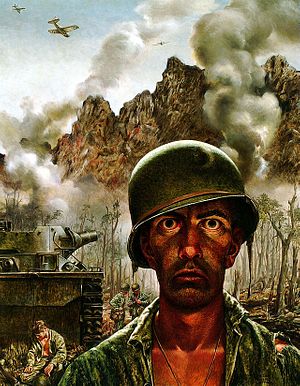The one thing defense analysts never talk about is violent death. While they are capable of superbly analyzing weapon systems, military doctrines, organizational structures and dissecting intricate details of what the future of war may look like, they rarely mention that the elephant in the livingroom of all their analyses is the violent killing of human beings.
The simple purpose of any military is to be an effective and expeditious killing machine—cloaked in the justifying mantle of national defense and as permitted by the “laws of war.” All the discussions about strategy, tactics, logistics, training, and procurement serve the single aim of killing men— and collaterally, or even intentionally, women and children—when elicited by the rationale or whim of state sponsored aggression.
Perhaps defense analysts do not discuss violent killing because it is all too obvious. Also, perhaps they do not fully assess or comprehend the implications of their analyses and commentaries. Or perhaps they willingly embrace doublethink euphemisms in which killing is replaced by value neutral terms which sanitize slaughter and normalize the polite punditry of bellicose hellfire.
Yet of course there is the inconvenient mythos of euphemism: It circumvents the truth. “If thoughts corrupt language, language can also corrupt thought,” as Orwell emphasizes. For example, juxtaposing the word defense with the word war automatically invokes a “positive” association with the former, and a “negative” threatening one with the latter, although they are essentially two sides of the same coin.
The field of defense analysis primarily talks about the preparation for and execution of war; the U.S. Department of Defense used to be called the Department of War before 1947. We have perverted Vegetius’ old axiom “Si vis pacem, para bellum” (If you want peace, prepare for war) by couching our theoretical preparation for war in an academic rhetoric that makes war and peace harder to distinguish.
Language has the capability to erase violence, notes Joanna Bourke in Deep Violence: Military Violence, War Play and the Social Life of Weapons:
One way it does this is by omitting the most salient features of an activity. At its most basic, weapon research, development and manufacture fails to acknowledge that the primary goal is to maim and kill other human beings.
Bourke summarizes some of the circumlocutions soldiers and analysts have chosen to use when talking about deadly weapons:
Napalm was called a ‘flak suppression weapon.’ Cluster bombs that would detonate in such a way that fragments would kill or wound people within an area of 300 by 900 metres (…) were ‘area denial’ weapons; such bombs,’suceed in silencing the weapons’ (that is the people holding the weapons and every living person within a wide radius). The Predator drone was ‘a big bee…with one hell of a sting’.
In her book she also cites a sociologist who noted in 1945 that technical discussions of weapon systems stupefies the public, fogging any clearheaded assessment of the real consequences of modern weapon systems. Bourke comments:
The hypnotic fascination with statistics and specifications enabled these men to disconnect their actions (care of weapons) from their consequences (corpses). They were just ‘screwing fuses into sockets’, as one bomb technician put it.
She continues:
Euphemism and military abstraction had an anesthetizing effect on participants of war and other militarist enterprises. They provided a substitute language, a numbing techno-speak.
I also must confess to a “numbing techno-speak” when writing and editing the Asia Defense section of The Diplomat. By elaborating on a new weapon system or new war fighting doctrine, I contribute to the perception of killing human beings with new military hardware as interesting, exciting and fun.
And while recognizing that there is a need to educate the public on such important matters as national defense, the purpose of this post is to bring home the fact that those of us writing on such matters should not do so lightly and without being aware of the brutal truth hiding behind the technical details of the next gun, the newest tank, and most advanced airplane discussed in this section of The Diplomat.
You smug-faced crowds with kindling eye
Who cheer when soldier lads march by,
Sneak home and pray you’ll never know
The hell where youth and laughter go.

































